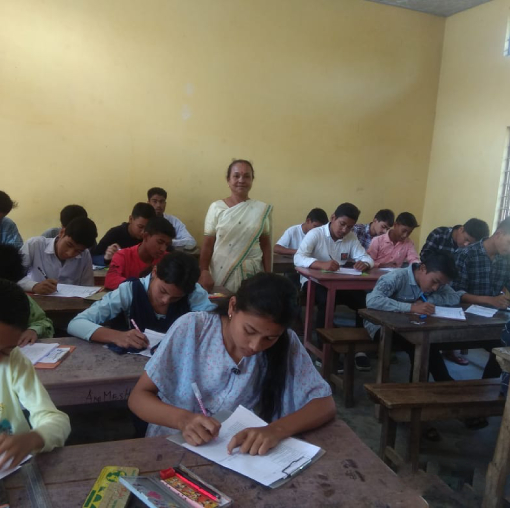Gopinath Bordoloi Rd, Opp. Rabindra Bhawan, Guwahati, Assam.
Our History & Legacy

About our History & Legacy
Origin
The Assam Science Society was established in 1953. It is a pioneer voluntary organization in the country. 26 science organizations, voluntary in nature, from all over India, gathered together to form All India Peoples' Science Network (AIPSN).
This forum organized a cultural campaign or Kala Jatra in 1987 to popularize science all over India. The campaign started from 5 places in India on the 2nd of October 1987. Each troupe consisted of a musical troupe and science experiment unit. The North-East group started from Golaghat and reached Bhopal on 7th of November. The outcome of this Kalajathra was that the organizers of these science Network realized that if science was to be reached to the people, the people must become literate.

During this period Kerala Shaksarata Sahitya Parishad was the only science society that was engaged in eradication of illiteracy in India. So, all the science societies requested them to go ahead with the program. So Ernakulam in Kerala became the first district to be declared fully literate. As a result, from 2nd October 1990, all Science Societies started a new program called "Gyan Vigyan Jatra 1990" for eradication of illiteracy. Prior to the jatra all science societies formed a Gyan Vigyan Samiti in their respective states. Thus was Gyan Vigyan Samiti formed. All the Gyan Vigyan Samitis are independent organisations. Then all the Gyan Vigyan Samitis joined together to form the Bharat Gyan Vigyan Samiti.
The National Literacy Mission lent a helping hand in this program. Success of Ernakulam Campaign was astounding. At the outset, the Education Department of Government of India proclaimed that the project was impractical and an illusion and fantasy. Whereas the National Literacy Mission felt the need of a campaign type of program in the first meeting of 1988. In 1989 Peoples' science forum submitted a project to NLM in the month of April to conduct an all India campaign for Literacy. Bharat Gyan Vigyan Samiti was registered and an Executive Committee of ten members was formed.
The Assam Science Society formed the Gyan Vigyan Samiti in Assam on 18th July 1990 in accordance with the earlier decision of Peoples' Science Movement. It was formed at a general meeting held at Handique Girls' College where the educationist late Dandeswar Gogoi, was selected the President and Dr. Debadatta Barkataki, the Secretary. It has 17 members in its Executive Committee.
Gyan Vigyan Jatra 1990 and its consequences:
This program started from various points of India from 2nd of October 1990. Inspite of the best efforts it could not be performed in Jammu and Kashmir, Goa, Mizoram, Nagaland, Arunachal Pradesh, Meghalaya and Sikkim. The Kalajatra was performed in 304 districts of India and covered 36495 villages.
The Kalajatra was able to involve people of all walks of life in its respective areas. The redeeming feature was that songs and street plays were composed and written within a very short time. All these songs and dramas were published by the Gyan Vigyan Samitis as its first priority service. The success story can be divided into three groups:
- Due recognition was given from all quarters to the fact that illiteracy was a problem. It was recognised as a major problem and people of all walks of life got involved in it.
- Gyan Vigyan Jatra proved that people belonging to different ideologies can work together on one platform. This campaign brought hope to the people and all believed that change was possible through literacy. Some also opined that the 1990 Kalajatra also brought new ground to a lot of social work.
- Ernakulam Literacy Movement inspired the fact that the Literacy Movement can be made successful with the co-operation of the people. Science activists began to refer to this change or inspiration as Ernakulam fever. This fever spread from district to district and thus Total Literacy Program came to stay. In many places volunteers came out to spread this fever.
TLC Interim Period (Jan, 1991 – March 1992):
During this period Gyan Vigyan Samiti activists of Assam participated in the following workshops for orientation in the literacy campaign. Some of them were like, Total Literacy Program Training Workshop at Ernakulam from 19-27 Feb. 1991, Executive Committee Meeting at Delhi 1-4 July 1991, Training Methodology of the Literacy Campaign at Delhi 24-27 August 1991, Post Literacy Workshop at Delhi 10-14 November 1991., etc.
Moreover, Gyan Vigyan Samiti, Assam had organised a number of workshops for the district activists to formulate rules and regulations for the Total Literacy Campaign through discussions. Some are like Total Literacy Campaign and Training(14-17 November, 1991), 15-18 December 1991 workshop where the participants from all over Assam prepared a book on monitoring called "Samakaran" in Assamese, along with the conduct of the first workshop on Assamese primer by the Assam Science Society on 12-15 June 1991.
During this period Gyan Vigyan Samiti Assam, with the help of Assam Science Society submitted a project proposal to conduct Total Literacy Campaign in 8 blocks of 6 districts. This project was approved by National Literacy Mission on 30th January, 1992. The primer published by GVS Assam was first used in Rangia Block Gram Swaraj Parishad of Rangia.
From April 1992 Onwards:
- Gyan Vigyan Samiti, Assam a part of Assam Science Society started Total Literacy Campaign in Assam from April 1992. To conduct the TLC in 8 blocks a number of camps and workshops were held both at state level in Guwahati and at block level to train the workers of various levels. Some of them are like:
- The Literacy Program and its Various Aspects:-Guwahati 20-23 April 1992.
- Literacy Campaign:- Training curriculum Guwahati 1-4 July 1992.
- Kalajatra Training Workshop:- Guwahati 21st July to 1st August 1992. Representatives of TLC blocks returned home to form their own Kalajatra group and perform in their respective areas. In the Guwahati workshop Sri Indra Bania, Sri Kula Barua and Sri Jagadish Baruah had rendered ample help and co-operation.
- Literacy Campaign:- Training: Guwahati 18-21 September 1992.
- Second Primer and Post Literacy Workshop, Guwahati, 19-22 February, 1993.
-
The Books Published:
Books that are necessary for the Total Literacy Campaign are published by GVS, Assam with the help of Assam Science Society.
Beyond Literacy - THE GVSA DREAM:
Beyond the movement of literacy, GVSA has been active in the areas that consider literacy as a precondition. In these areas due to presence of awareness and due to the existence of enthusiastic volunteers and participatory structures upto the village level, several campaigns were taken up. Some of them are:
- The Post Literacy Campaign
- Universalisation of Elelmentary Education
- Literacy to Library and Cultural Movements
- Literacy to Women's Emancipation
- Literacy to Health
- Literacy to Sustainable Self-Reliance
- Towards a Social Transformation
